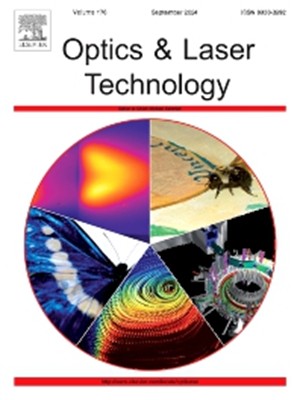Harmonic dichromatic soliton molecules in synchronous mode-locked fiber lasers
IF 4.6
2区 物理与天体物理
Q1 OPTICS
引用次数: 0
Abstract
Dichromatic soliton molecules, consisting of multiple optical solitons with two carrier frequencies, exhibit distinctive stability and intricate interaction dynamics in nonlinear systems. In this study, we experimentally generate harmonic dichromatic soliton molecules (HDSM) in a synchronously mode-locked fiber laser. By appropriately setting the pump power and adjusting the polarization controller to optimize the cavity state, we successfully generate 2nd-, 3rd-, and 4th-order HDSM, achieving a repetition rate of 76.582 MHz. Using the dispersive Fourier transform technique, we unveiled the various real-time spectral scenarios of these HDSMs. Furthermore, we observe the evolution dynamics of unequal spacing HDSM, which can be considered as 2+4 dichromatic soliton molecular complexes. All these findings provide an intriguing perspective in dynamical intra-molecular evolution of ultrafast nonlinear phenomena and further enrich the research of fundamental science.
求助全文
约1分钟内获得全文
求助全文
来源期刊
CiteScore
8.50
自引率
10.00%
发文量
1060
审稿时长
3.4 months
期刊介绍:
Optics & Laser Technology aims to provide a vehicle for the publication of a broad range of high quality research and review papers in those fields of scientific and engineering research appertaining to the development and application of the technology of optics and lasers. Papers describing original work in these areas are submitted to rigorous refereeing prior to acceptance for publication.
The scope of Optics & Laser Technology encompasses, but is not restricted to, the following areas:
•development in all types of lasers
•developments in optoelectronic devices and photonics
•developments in new photonics and optical concepts
•developments in conventional optics, optical instruments and components
•techniques of optical metrology, including interferometry and optical fibre sensors
•LIDAR and other non-contact optical measurement techniques, including optical methods in heat and fluid flow
•applications of lasers to materials processing, optical NDT display (including holography) and optical communication
•research and development in the field of laser safety including studies of hazards resulting from the applications of lasers (laser safety, hazards of laser fume)
•developments in optical computing and optical information processing
•developments in new optical materials
•developments in new optical characterization methods and techniques
•developments in quantum optics
•developments in light assisted micro and nanofabrication methods and techniques
•developments in nanophotonics and biophotonics
•developments in imaging processing and systems

 求助内容:
求助内容: 应助结果提醒方式:
应助结果提醒方式:


